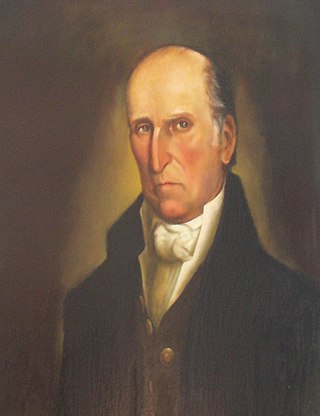
Hopewell is an independent city surrounded by Prince George County and the Appomattox River in the Commonwealth of Virginia, United States. At the 2020 census, the population was 23,033. The Bureau of Economic Analysis combines the city of Hopewell with Prince George County for statistical purposes.

Lee County is a county located in east central Alabama. As of the 2020 census the population was 174,241. The county seat is Opelika, and the largest city is Auburn. The county was established in 1866 and is named for General Robert E. Lee (1807–1870), who served as General in Chief of the Armies of the Confederate States in 1865. Lee County comprises the Auburn-Opelika, AL Metropolitan Statistical Area, which is included in the Columbus-Auburn-Opelika, GA-AL Combined Statistical Area.

Andrew Pickens was a militia leader in the American Revolution. A planter and slaveowner, he developed his Hopewell plantation on the east side of the Keowee River across from the Cherokee town of Isunigu (Seneca) in western South Carolina. He was elected as a member of the United States House of Representatives from western South Carolina. Several treaties with the Cherokee were negotiated and signed at his plantation of Hopewell.

The Hopewell tradition, also called the Hopewell culture and Hopewellian exchange, describes a network of precontact Native American cultures that flourished in settlements along rivers in the northeastern and midwestern Eastern Woodlands from 100 BCE to 500 CE, in the Middle Woodland period. The Hopewell tradition was not a single culture or society but a widely dispersed set of populations connected by a common network of trade routes.

The Tri-Cities of Virginia is an area in the Greater Richmond Region which includes the three independent cities of Petersburg, Colonial Heights, and Hopewell and portions of the adjoining counties of Chesterfield, Dinwiddie, and Prince George in south-central Virginia. Other unincorporated communities located in the Tri-Cities area include Ettrick, Fort Gregg-Adams, and City Point, the latter formerly a historic incorporated town which was annexed to become part of the City of Hopewell.

The Swift Creek culture was a Middle Woodland period archaeological culture in the Southeastern Woodlands of North America, dating to around 100-800 CE. It occupied the areas now part of Georgia, Alabama, Florida, South Carolina, and Tennessee. In Florida, Swift Creek ceremonial practices and burial complexes are referred to technically as the Yent-Green Point complex. The Swift Creek culture was contemporaneous with and interacted with the Hopewell culture; Swift Creek is often described as "Hopewellian." The type site for the Swift Creek culture was the Swift Creek mound site, which was located in Bibb County, Georgia. The Leake Mounds are another significant Swift Creek Culture site in Georgia.
Oakville is an unincorporated community located in the southeast corner of Lawrence County, Alabama, United States. The community has two parks, one dedicated to 20th-century African-American athlete Jesse Owens and the other to Middle Woodland period and Cherokee Native Americans.
Hopewell is an unincorporated community in Cherokee County, Alabama, United States. It lies at an elevation of 587 feet.
Hopewell is an unincorporated community in DeKalb County, Alabama, United States.

Hopewell is an unincorporated community in Cleburne County, Alabama, United States. It lies at an elevation of 1060 feet.
Hopewell is an unincorporated community in Jefferson County, Alabama, United States. Today it lies mostly within the corporate limits of the City of Bessemer. The historic Sadler Cemetery lies nearby which contain the graves of many pioneer settlers of western Jefferson County.
Hopeful is an unincorporated community in Talladega County, Alabama, United States. The community was named for Hopeful Church of Christ, which was founded in 1878 by W. J. Camp.
Hopewell is an unincorporated community in Hillsborough County, Florida, United States. It lies at an elevation of 102 feet (31 m) above sea level. Hopewell is located along Florida State Road 60 at the intersection of Hillsborough County Road 39 and southern terminus of Florida State Road 39.
New Hopewell may refer to:

The Columbus–Auburn–Opelika, GA–AL Combined Statistical Area is a trading and marketing area made up of six counties in Georgia and two in Alabama. The statistical area includes two metropolitan areas: the Columbus metropolitan area and the Auburn–Opelika metropolitan area. As of 2021, the CSA had a population of 503,709.

Beauregard High School is a high school in Beauregard, Alabama, enrolling grades 9-12. The school enrolls 584 students, and is one of four high schools in the Lee County School District along with Beulah, Loachapoka, and Smiths Station High Schools. Beauregard High School is named for Confederate Army general P.G.T. Beauregard.
The Grand Gulf Mound (22CB522) is an Early Marksville culture archaeological site located near Port Gibson in Claiborne County, Mississippi, on a bluff 1 mile (1.6 km) east of the Mississippi River, 2 miles (3.2 km) north of the mouth of the Big Black River. The site has an extant burial mound, and may have possibly had two others in the past. The site is believed to have been occupied from 50 to 200 CE. Copper objects, Marksville culture ceramics and a stone platform pipe were found in excavations at the site. The site is believed to be the only site in the Natchez Bluffs region to have been actively involved in the Hopewell Interaction Sphere. It is one of four mounds in the area believed to date to the Early Marksville period, the other three being the Marskville Mound 4 and Crooks Mounds A and B, all located in nearby Louisiana. The mound itself was built in several stages over many years, very similar to the Crooks Mound A in La Salle Parish, Louisiana. Unlike some other Hopewell sites, such as the Tremper Mound in Scioto County, Ohio, the site showed no evidence of a mortuary or communal structure previous to the construction of the mound. The beginning stage is believed to have been a rectangular earthen platform .5 feet (0.15 m) in height, 20 feet (6.1 m) wide on its east–west axis and 3.5 feet (1.1 m) long on its north–south axis. After a period of use, this platform was covered with a mantle of earth 5.5 feet (1.7 m) in height and 26.5 feet (8.1 m) wide along its east–west axis, with an extremely hard cap of earth 0.2 feet (0.061 m) covering the mound. During a third stage another mantle of earth was added to the mound, bringing it to a height of 10 feet (3.0 m) and to approximately 32 feet (9.8 m) in width on its east–west axis.
The Treaty of Turkeytown, also known as the Treaty with the Cherokee and the Treaty of Chickasaw Council House (Cherokee) was negotiated on 14 September 1816, between delegates of the former Cherokee Nation on the one part and Major General Andrew Jackson, General David Meriwether and Jesse Franklin, Esq., who served as agents of the United States in the capacity of "commissioners plenipotentiary", on the other part. Conducted following the Creek War, the initial meeting was held at the Chickasaw Council House and stipulated a further meeting on 28 September 1816, to be conducted at "Turkey's Town", on the Coosa River, near the present day town of Centre, in Cherokee County, Alabama. The treaty was ratified by the Cherokee Nation at Turkeytown on 4 October 1816, and signed by Pathkiller, then Principal Chief of the Cherokee Nation.












